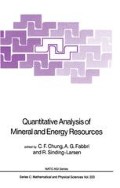Abstract
The evaluation of regional geochemical data normally begins with a univariate analysis of each element. Patterns within the data are frequently recognized, but in cases where the patterns are obscure or not immediately understood, or where a large number of elements make interpretation difficult, a multivariate analysis is commonly undertaken. Unfortunately, this analysis is often made without consideration of the univariate results. Ignoring discernable univariate patterns in the design of subsequent multivariate analyses may lead to unneccessary ambiguities and/or complexities in the multivariate results and the subsequent interpretation. Geochemical concentration data from a soil survey in northern British Columbia are used to demonstrate this point. Univariate examination of the data reveals that most elements are bimodally distributed. However, the elements could be divided into two groups differing in the relative contribution of the two component populations (modes) making up their distributions. One group of elements has bimodal distributions with component populations of approximately equal size (55% and 45%); the other has bimodal distributions with component populations of vastly different size (90% and 10%).
This information was used in three subsequent principal component (PC) analyses. The PC loadings and scores from (1) an analysis of all elements in the data set (the standard approach) were compared with the loadings and scores from two other PC analyses. These include (2) an analysis which used only those elements with distributions containing component populations of approximately equal size (55:45), and (3) an analysis which used those elements with distributions containing component populations of vastly unequal size (90:10). Combined results from the two “structured” PC analyses (2 and 3) relate better to the geology and mineral deposits in the survey area than results from the wholesale, “unstructured” PC analysis (1). Furthermore, patterns from the “structured” PC analyses are more distinct than the wholesale PC analysis and lead to a less ambiguous and more complete interpretation.
The “structured” approach to multivariate analysis, which uses information from the univariate analysis in its design, thus represents a logical and superior data evaluation philosophy.
Access this chapter
Tax calculation will be finalised at checkout
Purchases are for personal use only
Preview
Unable to display preview. Download preview PDF.
References
Diakow, L.J. and Panelayev, A., 1981, “Cassiar Gold Deposits, McDame Map Area in Geological Fieldwork, 1980, British Columbia Ministry of Energy, Mines, and Petroleum Resources Paper 1981–1, pp. 55–62.
Gabrielse, H., 1963, “McDame Map Area, Cassiar, British Columbia”,Geologic Survey of Canada, Memoir 319, 139 p.
Gordy, S.P. , Abbott, J.G., and Orchard, M.J. , 1982, “Stratigraphy and Structure of the Sylvester Allochthon, Southwest McDame Map Area, Northern British Columbia” in Current Research, Part B, Geologic Survey of Canada Paper 82–1B, p. 101–106.
Gower, S.J., Clark, A.H., and Hodgson, C.J., 1985, “Tungsten-Molybdenum Skarn and Stockwork Mineralization, Mount Reed-Mount Haskin District, Northern British Columbia, Canada”, Canadian Journal of Earth Sciences, Vol. 22, No. 5, pp. 728–747.
Sinclair, A.J., 1976, “The Application of Probability Plots to Mineral Exploration”,Special Volume # 4, Association of Exploration Geochemistry, 95 p.
Somerville, R., and Smit, H., 1985, “A Geochemical, Physical, and Prospecting Report on the Beaver Claim, Cassiar District, Liard Mining Division”, British Columbia Assessment Report, 14 p.
Author information
Authors and Affiliations
Editor information
Editors and Affiliations
Rights and permissions
Copyright information
© 1988 D. Reidel Publishing Company, Dordrecht, Holland
About this chapter
Cite this chapter
Stanley, C.R., Sinclair, A.J. (1988). Univariate Patterns in the Design of Multivariate Analysis Techniques for Geochemical Data Evaluation. In: Chung, C.F., Fabbri, A.G., Sinding-Larsen, R. (eds) Quantitative Analysis of Mineral and Energy Resources. NATO ASI Series, vol 223. Springer, Dordrecht. https://doi.org/10.1007/978-94-009-4029-1_7
Download citation
DOI: https://doi.org/10.1007/978-94-009-4029-1_7
Publisher Name: Springer, Dordrecht
Print ISBN: 978-94-010-8288-4
Online ISBN: 978-94-009-4029-1
eBook Packages: Springer Book Archive

